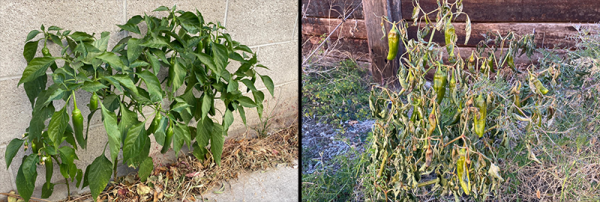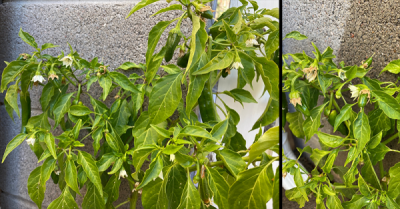December 4, 2021
Microclimate Control
Question:
How long can I leave green tomatoes on the plant before they’re ruined by a frost?
- submitted by Curry County Extension Agriculture Agent Mason Grau
Answer:
If temperatures are expected to drop near freezing in your area and you leave fruit on the plants, you’re pushing it. Maybe your neighborhood is a little warmer than the surrounding areas, and you’ll get a few extra days (or even weeks) for fruit to ripen outside. Maybe your plants are in a hot microclimate in your yard where they’re safer. Maybe temperatures drop below freezing in your yard, but only for a few minutes, so the more exposed tomatoes get burned by frost and turn to mush, but most of the tomatoes tucked in under the leaves go untouched.

The effects of microclimates can be dramatic. Seasoned gardeners have learned—often the hard way—how to maximize production by micromanaging their microclimates. As my predecessors explained in archived columns from years past,
"Your friends across town or a mile away will have some differences in gardening conditions due to the microclimates you will find in your area. In fact, there will be a significant microclimate difference between the north and south side of your own home” as depicted in the (SWYG) February 29, 2014 column.
- Dr. Curtis Smith
“By taking advantage of microclimates in the garden, New Mexicans can extend the growing season for many vegetables. Planting watermelons and cantaloupes near a block wall with southern exposure, for example, will increase the average temperature surrounding melon vines. On the other hand, planting cool-season crops like leaf lettuce, spinach, and cabbage on the north side of a house will help lower the temperature” as seen in the Melon Patch - April 2001 article.
– Dr. George Dickerson

It’s too hard to recommend precisely when to harvest the final fruits without knowing the microclimate and the forecast really, really well. Gardener and pollinator enthusiast Elliott Gordon lives near the Albuquerque foothills and reported that his pepper plants were still flowering and producing fruit as of November 21. Nearby temperatures had recently dropped as low as 27°F in another part of the same yard. Talk about a microclimate effect; these particular peppers were volunteers this year and are growing in the crack between a concrete driveway and a south-facing cinderblock wall. I was curious to know how temperatures in that spot differed from colder, more exposed spaces, so I dropped off a few mini temperature data loggers to be placed strategically around Gordon’s yard. The results shocked both of us. On the night of November 25, low temperatures ranged from 31.0°F all the way down to 15.7°F! Before asking what time those lowest lows were recorded, I checked my favorite source for wind data visualization, Ventusky, to see if wind patterns changed in the night, bringing cold air down from Sandia Peak. Sure enough, from about 3 to 6 am, “gusts” up to 11 mph were swooping down off the mountains, cooling the Albuquerque foothills. According to Gordon’s data, those lowest temps occurred between 5 and 6 am.
Are the flowers on those pepper plants going to remain viable and develop into fruit for a winter solstice harvest? Not likely. Even if the plants themselves keep trucking in their hot spot, in order for fruit to set, nighttime temperatures generally need to remain above 60°F. The blossoms are probably going to drop any day now.
According to several weather websites, this year’s first frost in Clovis was in early November, with temperatures dipping down into the low 20s by mid-month. The average first frost date for Curry County is in mid to late October. By now, even the warmest parts of the state are past their average first frost dates, so if they haven’t frozen yet, it won’t be long. To check your average first—and last—frost dates, visit Plant Maps, type in your ZIP Code, and scroll down to the “Additional Gardening Related Data” section. Keep in mind that the average frost dates vary based on which range of years are used and the microclimate where the data is collected.

Marisa Y. Thompson, PhD, is the Extension Horticulture Specialist, in the Department of Extension Plant Sciences at the New Mexico State University Los Lunas Agricultural Science Center, email: desertblooms@nmsu.edu, office: 505-865-7340, ext. 113.
Links:
For more gardening information, visit the NMSU Extension Horticulture page at Desert Blooms and the NMSU Horticulture Publications page.
Send gardening questions to Southwest Yard and Garden - Attn: Dr. Marisa Thompson at desertblooms@nmsu.edu, or at the Desert Blooms Facebook page.
Please copy your County Extension Agent and indicate your county of residence when you submit your question!